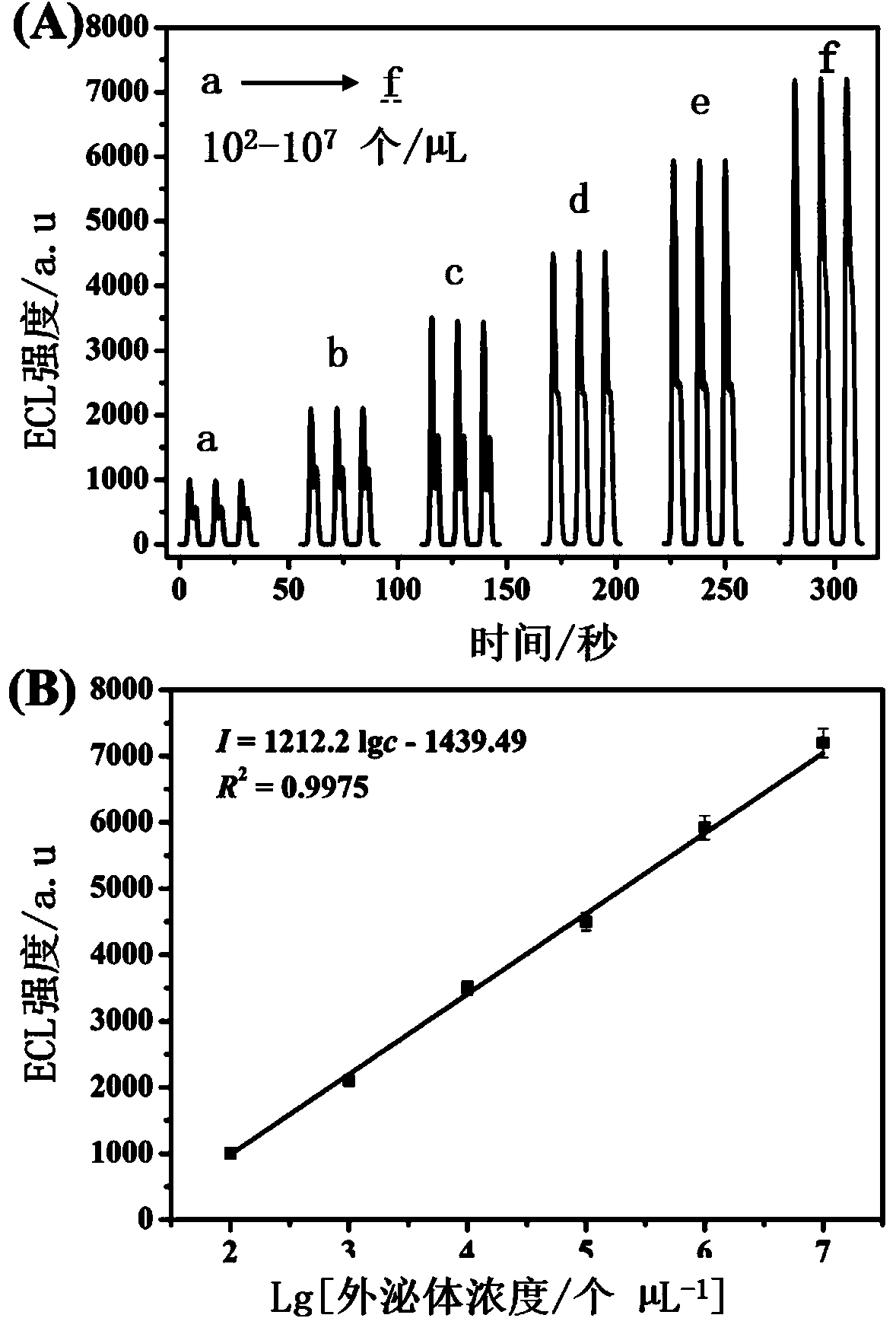Biosensor for detecting PS exosome and preparation method of biosensor
A biosensor and biosensing technology, applied in the direction of chemiluminescence/bioluminescence, instruments, measuring devices, etc., can solve the problems of lack of stability, denaturation, low sensitivity, etc., and achieve the effect of improving selectivity and stability
- Summary
- Abstract
- Description
- Claims
- Application Information
AI Technical Summary
Problems solved by technology
Method used
Image
Examples
Embodiment 1
[0026] 1. g-C 3 N 4 Synthesis of Nanosheets and Luminol-AuNPs
[0027] Preparation of g-C by direct pyrolysis of melamine 3 N 4 . The melamine was heated at 550°C for 4 hours, held at this temperature for a further 4 hours and cooled to room temperature. The resulting yellow product is then lumpy g-C 3 N 4 powder. Synthesize g-C as follows 3 N 4 Nanosheets: to 1 g of the bulk g-C 3 N 4 Add 100 mL 5mol / L HNO to the powder 3 , reflux at 125 °C for 24 h, and cool at room temperature. The white product was centrifuged at 12000 rpm, washed with ultrapure water to near neutral pH, and redispersed in water. To obtain uniformly sized nanosheets, the resulting suspension was sonicated for 4 h and then centrifuged at 8000 rpm for 30 min to remove residual unexfoliated g-C 3 N 4 Nanoparticles and large-area nanosheets. Then, the obtained supernatant was centrifuged at 5000 rpm to remove the suspension. Finally, the product was dried in a vacuum oven at 35 °C for 12 hours...
Embodiment 2
[0037] 1. Luminol-AuNPs@g-C 3 N 4 Synthesis of / PS recognition peptide probes
[0038] 100 mg g-C 3 N 4 After mixing the nanosheets and 50 mL luminol-AuNPs solution evenly, stir at room temperature for 18 h, and then centrifuge at 6000 rpm for 30 minutes to remove the supernatant to obtain luminol-AuNPs@g-C 3 N 4 Precipitate, figure 2 For Luminol-AuNPs@g-C 3 N 4 Transmission electron microscope image of a nanomaterial. The resulting luminol-AuNPs@g-C 3 N 4 Luminol-AuNPs@g-C can be obtained by combining the precipitate with the recognition peptide through thiol-gold coordination at 30°C for 6 h 3 N 4 / PS recognizes a peptide signaling probe.
[0039] 2. Assembly of the biosensor
[0040] Using 1% chloroauric acid solution as the reaction electrolyte, AuNPs were modified onto the glassy carbon electrode by potentiostatic deposition at -0.2 V for 30 s, rinsed and dried; then the modified electrode was immersed in 0.5 μM recognition peptide solution4 Incubate at ℃ f...
Embodiment 3
[0044] 1. Luminol-AuNPs@g-C 3 N 4 Synthesis of / PS recognition peptide probes
[0045] 50 mg g-C 3 N 4 After mixing the nanosheets and 100 mL luminol-AuNPs solution evenly, stir at room temperature for 36 h, and then centrifuge at 6000 rpm for 30 min to remove the supernatant to obtain luminol-AuNPs@g-C 3 N 4 Precipitate, figure 2 For Luminol-AuNPs@g-C 3 N 4 Transmission electron microscope image of a nanomaterial. The resulting luminol-AuNPs@g-C 3 N 4 Luminol-AuNPs@g-C can be obtained by combining the precipitate and the recognition peptide through the coordination of thiol and gold at 40°C for 8 h 3 N 4 / PS recognizes a peptide signaling probe.
[0046] 2. Assembly of the biosensor
[0047] Using 1% chloroauric acid solution as the electrodeposition base solution, AuNPs were modified on the glassy carbon electrode by constant potential deposition at -0.2 V for 20 s, rinsed and dried; then the modified electrode was immersed in 1 μM recognition peptide solution4...
PUM
 Login to View More
Login to View More Abstract
Description
Claims
Application Information
 Login to View More
Login to View More - R&D
- Intellectual Property
- Life Sciences
- Materials
- Tech Scout
- Unparalleled Data Quality
- Higher Quality Content
- 60% Fewer Hallucinations
Browse by: Latest US Patents, China's latest patents, Technical Efficacy Thesaurus, Application Domain, Technology Topic, Popular Technical Reports.
© 2025 PatSnap. All rights reserved.Legal|Privacy policy|Modern Slavery Act Transparency Statement|Sitemap|About US| Contact US: help@patsnap.com



